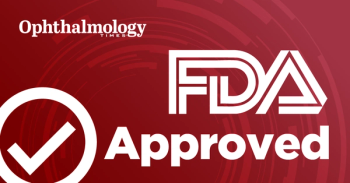
- Ophthalmology Times: January 2021
- Volume 46
- Issue 1
Zeroing in on dry eye treatment for patients with cataracts
Study supports preoperative ocular surface optimization with artificial tears.
Even patients without pre-existing
The researchers analyzed data from the Standard Patient Evaluation of Eye Dryness (SPEED) questionnaire, tear breakup time (TBUT) measurements, and corneal fluorescein staining (CFS) in 3 groups of patients.
Related:
The groups comprised those who did not use any artificial tears perioperatively (n = 140); patients who began to instill artificial tears 1 week preoperatively and continued for 2 months postoperatively (n = 139); and a cohort that used artificial tears postoperatively for 2 months (n = 140).
The DED-related evaluations were performed preoperatively and at follow-up visits occurring at 1, 4, and 8 weeks after surgery.
The artificial tear product was a commercially available lubricant formulation containing hydroxypropyl guar and hyaluronic acid, and all patients were treated with the same perioperative regimen of antibiotic and anti-inflammatory medications.
The results, published in Clinical Ophthalmology,1 showed statistically significant benefits of treatment with the artificial tears for mitigating surgically induced signs and symptoms of DED.
Statistically significant differences favoring the group that started using the artificial tears preoperatively compared with the group using the ocular lubricant only after surgery were seen in analyses of SPEED scores and TBUT.
Related:
Based on the findings, the investigators concluded that the artificial tears were effective in protecting the ocular surface, particularly if initiated in the preoperative period.
Noting that DED can lead to biometric errors and adversely affect patient comfort and vision after surgery, they stated that the findings highlight the importance of improving the homeostasis of the ocular surface not only in patients with established DED but also in those without frank disease or evident DED risk factors.
Study design
The study identified patients who had undergone unilateral cataract surgery across 17 centers in Italy.
A total of 419 patients met the inclusion criteria that required eligible patients to be aged at least 50 years and have undergone an uncomplicated procedure with a clear corneal incision, IOL implantation in the capsular bag, and postoperative treatment with dexamethasone and tobramycin 4 times a day for 10 days and nepafenac 0.1% 3 times a day for 1 month.
Related:
In addition, patients needed to have data from DED diagnostic tests conducted between 30 and 7 days before surgery and at 1, 4, and 8 weeks postoperatively.
Patients were excluded if they had preexisting DED, which was diagnosed based on a Schirmer test without anesthesia less than 7 mm/5 min, TBUT less than 10 seconds, SPEED score greater than 4, and CFS score greater than 1, or if they had any other findings that could confound the results.
Preoperatively, the 3 study groups were well matched with respect to mean age ( ~ 72 years), mean Schirmer test score ( ~ 13 mm/5 min), mean TBUT ( ~ 12 sec), and percentage of eyes with a CFS score equal to 0 (65% to 76%).
The postoperative data from all groups were consistent with previous reports showing that cataract surgery can induce signs and symptoms of DED.
Mean SPEED questionnaire scores did not change significantly in groups that were using artificial tears but increased significantly (worsened) at week 4 in the untreated patients.
The differences in mean SPEED scores were statistically significant favoring both groups using the artificial tears versus the untreated group at all follow-up visits.
The investigators noted that 25% of the patients in the untreated group had SPEED scores corresponding to mild-moderate dry eye symptoms at 8 weeks after surgery.
Related:
In addition, a statistically significant difference favoring the group starting artificial tear use preoperatively compared with the group treated only postoperatively was noted at postoperative weeks 1 and 4.
The TBUT was significantly higher in both groups using the artificial tears compared with the controls at all follow-up visits, and mean TBUT fell to below 10 seconds postoperatively only in the control group.
In addition, TBUT recovered faster in the group using artificial tears preoperatively compared with the group that was treated only after surgery. At the week 4 postoperative visit, the TBUT was higher in the group that started artificial tear use preoperatively compared with the group treated only postoperatively.
The investigators noted the difference was statistically significant, but it was not clinically significant.
The results for CFS showed that patients using artificial tears had less corneal damage after surgery than their untreated counterparts.
Among patients who used the artificial tears preoperatively and postoperatively, a small minority had CFS scores of 2 (7.2%) or 3 (0.7%) at the week 1 postoperative visit.
In this same group by week 4, more patients had a CFS score of 0 compared with baseline, and the percentage was increased further at week 8.
A similar pattern of early worsening in CFS scores and subsequent progressive improvement was noted in the group that used artificial tears postoperatively only and in the untreated group.
However, among patients who used the artificial tears after surgery, approximately 6% of patients had a CFS score greater than 1 at week 4, whereas in the untreated group a CFS score greater than 1 was found in 20% of eyes at week 1, 13% at week 4, and 6.4% at week 8.
--
Reference
1. Favuzza E, Cennamo M, Vicchio L, Giansanti F, Mencucci R. Protecting the ocular surface in cataract surgery: the efficacy of the perioperative use of a hydroxypropyl guar and hyaluronic acid ophthalmic solution. Clin Ophthalmol. 2020;14:1769-1775. doi:10.2147/OPTH.S259704
Articles in this issue
almost 5 years ago
Research is unfolding the proteins in retinitis pigmentosaalmost 5 years ago
Physicians discuss advancements in the treatment of wet AMDalmost 5 years ago
Combination drops may help patients challenged by multiple glaucoma medsalmost 5 years ago
Developments in glaucoma offering hope, optionsalmost 5 years ago
Anti-VEGF medications may cause systemic complications in ROPalmost 5 years ago
Harnessing 1-2 punch of KAMPs for corneal infection, inflammationalmost 5 years ago
Study: Innovative dexamethasone formulation shows efficacy, safetyalmost 5 years ago
Transscleral laser therapy device simplifies procedurealmost 5 years ago
It takes a village to beat visual system diseases in childrenalmost 5 years ago
The value of new diagnostics and personalized medicineNewsletter
Don’t miss out—get Ophthalmology Times updates on the latest clinical advancements and expert interviews, straight to your inbox.














































.png)


